Tyson Foods Bundle
Can Tyson Foods Continue to Dominate the Protein Market?
Tyson Foods, a titan in the global protein market, is navigating a complex landscape of evolving consumer preferences and industry shifts. Its recent turnaround in the Chicken segment showcases the company's adaptability and commitment to operational excellence. From its roots in 1935, Tyson has become a household name, offering iconic brands and a vast product portfolio. Understanding Tyson Foods' Tyson Foods SWOT Analysis is crucial to grasping its strategic direction.
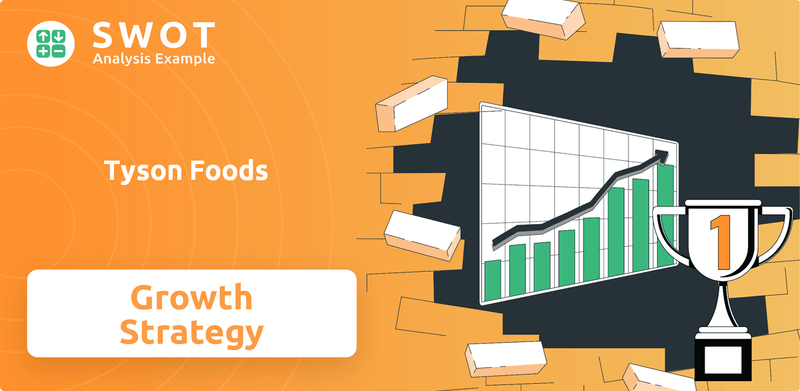
This deep dive into Tyson Foods' growth strategy will explore its future prospects, considering the latest food industry trends and meat processing market dynamics. We'll analyze its strategic initiatives for 2024, including expansion plans and innovation in protein, while also examining its financial performance review and impact on local communities. Furthermore, this analysis will provide insights into Tyson Foods' competitive landscape and long-term growth potential, offering a comprehensive perspective for investors and stakeholders alike, considering sustainable food practices.
How Is Tyson Foods Expanding Its Reach?
The expansion initiatives of the company are central to its strategy, focusing on both market penetration and product diversification. The company is strategically positioned to capitalize on the rising global demand for protein-rich foods. This involves entering new markets and establishing partnerships with local distributors, with anticipated improvements in fiscal 2025 results on an adjusted basis.
Product innovation is another key area, particularly in response to changing consumer preferences. This includes expanding offerings to include plant-based protein alternatives. The company is also investing in its existing facilities to enhance capacity and efficiency, such as the $180 million expansion at its Caseyville Prepared Foods facility, completed by late 2024.
Strategic partnerships and investments are also crucial for unlocking new markets and contributing to the company's global expansion. The company's enterprise priorities for fiscal 2025 include strengthening iconic brands to expand reach and introducing innovations for new consumption occasions. These initiatives are designed to drive long-term growth and adaptability in the dynamic food industry.
The company is actively targeting international markets to meet the growing global demand for protein products. This includes entering new markets and forming partnerships with local distributors. Investments in international operations are expected to yield improved results in fiscal 2025.
The company is expanding its product offerings to include plant-based protein alternatives. This strategy leverages the company's expertise in food processing and distribution. The focus is on adapting to changing consumer preferences and capitalizing on the growing market for sustainable food practices.
The company is investing in existing facilities to enhance capacity and improve efficiency. An example is the $180 million expansion at the Caseyville Prepared Foods facility, completed in late 2024. This expansion added 400 new jobs and integrated automation across seven new production lines.
The company is forming strategic partnerships, such as a $1 billion collaboration with Lineage Logistics. Investments, like those in Brazil's Grupo Vibra, are also unlocking new markets. These collaborations support the company's global expansion and enhance its market share analysis.
The company's expansion plans are focused on several key areas to drive growth. These initiatives include global market expansion, product innovation, and strategic partnerships. These actions are designed to strengthen the company's position in the competitive landscape.
- Expanding into new international markets to meet global demand.
- Developing and introducing innovative products, including plant-based options.
- Investing in existing facilities to increase capacity and efficiency.
- Forming strategic partnerships to unlock new markets and enhance distribution.
Tyson Foods SWOT Analysis
- Complete SWOT Breakdown
- Fully Customizable
- Editable in Excel & Word
- Professional Formatting
- Investor-Ready Format
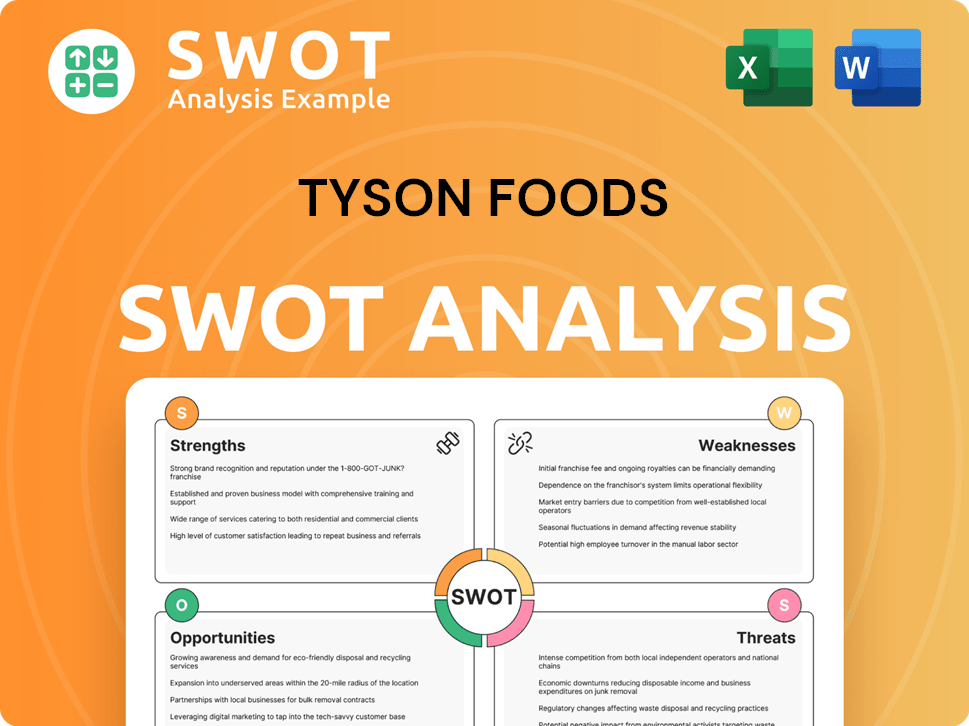
How Does Tyson Foods Invest in Innovation?
The company is heavily investing in innovation and technology to drive its Tyson Foods growth strategy. This approach focuses on operational excellence and digital transformation to maintain a competitive edge in the meat processing market. The goal is to meet evolving consumer expectations and food industry trends while ensuring long-term profitability.
Tyson Foods future prospects are significantly influenced by its strategic initiatives in technology and sustainability. The company's commitment to reducing its environmental impact and improving operational efficiency positions it well for future growth. These initiatives are designed to meet the increasing demand for sustainable and responsibly produced food products.
The company's focus on technological advancements and sustainability initiatives is a key component of its overall strategy. This includes investments in automation, artificial intelligence, and renewable energy sources. These efforts are designed to improve efficiency, reduce costs, and meet the growing demand for sustainable products, which is crucial for long-term success.
The company is investing $1.3 billion in automation. This investment has resulted in a 20% improvement in production efficiency. The company also achieved a 15% reduction in operational costs by 2025, surpassing its initial cost-saving target for 2024.
The company utilizes AI-driven analytics, advanced robotics, and smart logistics systems. These technologies streamline workflows, reduce waste, and optimize supply chain routes. This digital transformation supports the company's efforts to improve efficiency and sustainability.
The company's venture capital arm, Tyson Ventures, actively collaborates with external innovators. The company held a Demo Day in 2024, focusing on supply chain innovation. They selected five startups to work on solutions involving AI, cold chain management, and cloud platforms.
Tyson Demo Day 2025, scheduled for July 9, 2025, will focus on advancing artificial intelligence in food technology. The event will emphasize consumer and customer brand engagement, innovation in research and development, and reimagining product development processes.
Since its inception in 2016, Tyson Ventures has invested over $100 million in emerging proteins, new technologies for food and worker safety, and improved food production. This demonstrates the company's commitment to innovation and future-proofing its operations.
The company aims for net-zero greenhouse gas emissions across its global operations and supply chain by 2050. It plans to increase renewable energy usage in U.S. operations to 50% by 2030. The company also aims to implement sustainable beef production practices on 5 million acres of grazing lands by 2025.
The company’s strategic initiatives are centered on technological advancements, sustainability, and operational efficiency. These initiatives are critical for long-term growth and are designed to adapt to changing food industry trends and consumer preferences. For more details on the marketing strategies, see the Marketing Strategy of Tyson Foods.
- Automation and AI: Deploying advanced technologies to streamline processes and reduce costs.
- Sustainability: Reducing environmental impact through renewable energy and sustainable practices.
- Innovation: Investing in emerging proteins and new technologies to improve food production.
- Supply Chain Optimization: Enhancing logistics and reducing waste through smart systems.
Tyson Foods PESTLE Analysis
- Covers All 6 PESTLE Categories
- No Research Needed – Save Hours of Work
- Built by Experts, Trusted by Consultants
- Instant Download, Ready to Use
- 100% Editable, Fully Customizable
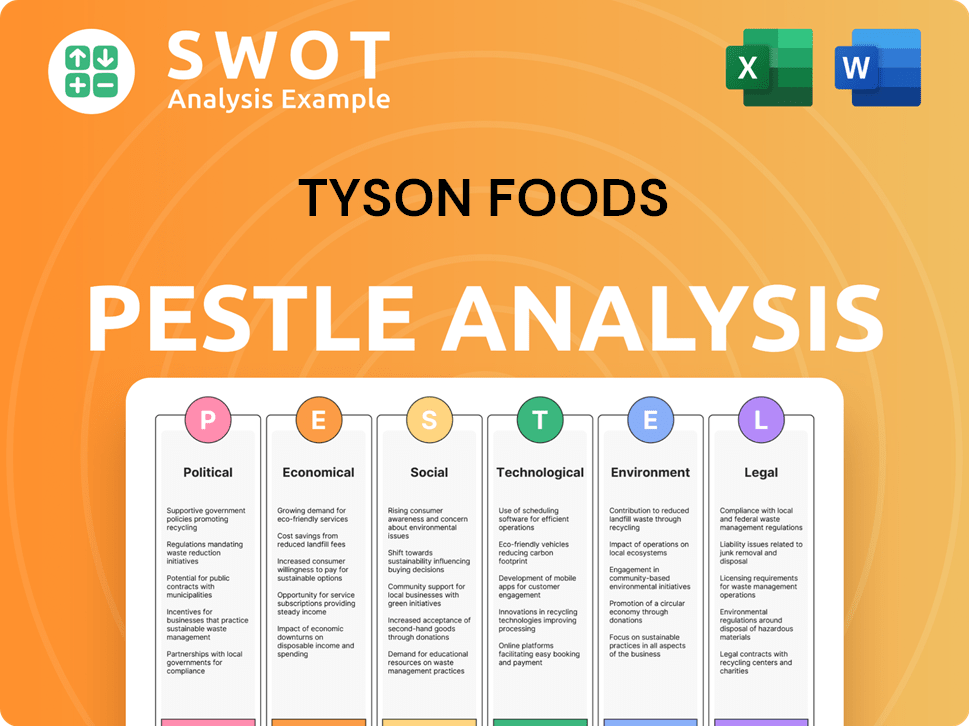
What Is Tyson Foods’s Growth Forecast?
The financial outlook for Tyson Foods in fiscal year 2025 indicates a strategic focus on sustained growth and improved financial performance. The company's projections reflect a careful balance between addressing market challenges and capitalizing on opportunities within the food industry. This outlook is crucial for understanding the future prospects of the company and its position within the meat processing market.
For fiscal 2025, the company anticipates sales to remain flat to increase by 1% compared to fiscal 2024, even with a $343 million reduction due to legal contingency accruals recognized in the second quarter of fiscal 2025. This projection is supported by strategic initiatives aimed at enhancing operational efficiency and expanding market reach. Investors and stakeholders should closely monitor these developments to assess the company's ability to navigate the competitive landscape and achieve its financial targets.
Total company adjusted operating income is projected to be between $1.9 billion and $2.3 billion for fiscal 2025. This forecast aligns with the management's expectation of a 10% growth in adjusted operating income, driven primarily by the Prepared Foods and Chicken segments. This growth strategy underscores the company's commitment to innovation in protein and its ability to adapt to evolving consumer behavior and food industry trends.
The Chicken segment is forecasted to continue its strong performance, with an anticipated adjusted operating income of $1.0 billion to $1.3 billion. The Prepared Foods segment is expected to deliver adjusted operating income of $0.9 billion to $1.1 billion. These segments are key contributors to the overall growth strategy.
The Beef segment is anticipated to remain challenging, with an expected adjusted operating loss between $(0.4) billion and $(0.2) billion for fiscal 2025. The Pork segment is projected to contribute adjusted operating income of $0.1 billion to $0.2 billion. The company is working on strategies to mitigate these challenges.
Capital expenditures are planned to be between $1.0 billion and $1.2 billion for fiscal 2025, with a focus on profit improvement projects. The company expects liquidity to remain above its minimum target of $1.0 billion. Free cash flow is projected to be between $1.0 billion and $1.6 billion for fiscal 2025.
Net interest expense is approximated at $375 million for fiscal 2025. The adjusted effective tax rate is expected to be around 25%. These financial metrics are essential for assessing the overall financial health and investment opportunities of the company. For more context, explore the Brief History of Tyson Foods.
In fiscal year 2024, Tyson Foods reported total sales of approximately $53.3 billion, an increase of 0.8% from the prior year. The company's adjusted operating income was $1.820 billion, up 95% from the prior year. This strong performance sets a solid foundation for the company's future prospects and long-term growth potential.
- Total Sales: Approximately $53.3 billion
- Sales Growth: 0.8% increase year-over-year
- Adjusted Operating Income: $1.820 billion
- Operating Income Growth: 95% increase year-over-year
Tyson Foods Business Model Canvas
- Complete 9-Block Business Model Canvas
- Effortlessly Communicate Your Business Strategy
- Investor-Ready BMC Format
- 100% Editable and Customizable
- Clear and Structured Layout
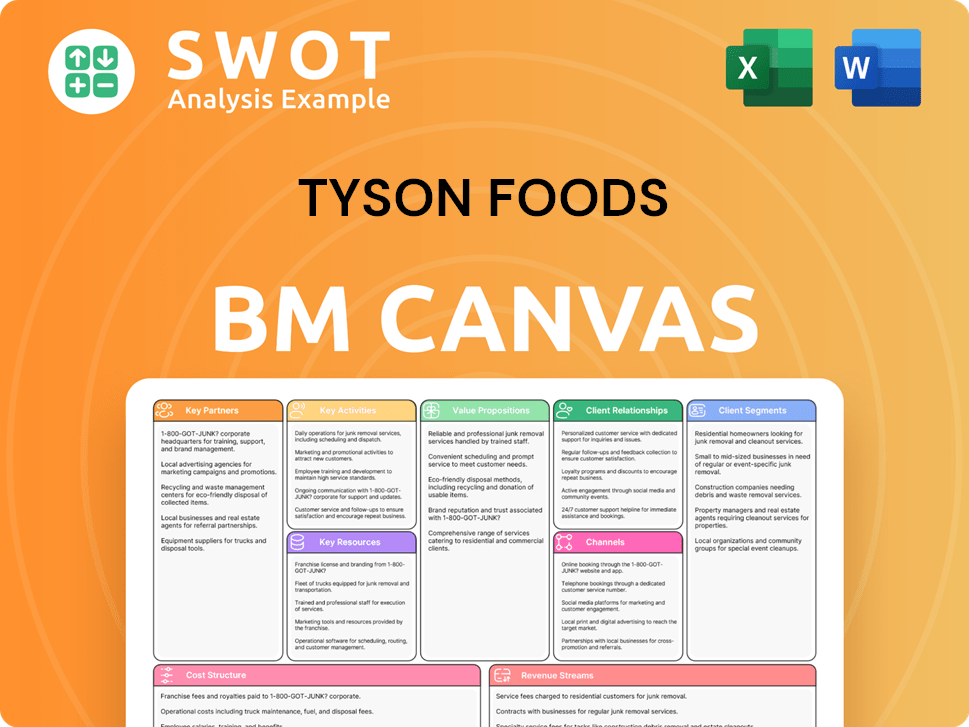
What Risks Could Slow Tyson Foods’s Growth?
Several risks and obstacles could affect the Tyson Foods growth strategy and its future prospects. These challenges span operational, market, and regulatory landscapes, requiring strategic adaptability to maintain and enhance performance. Understanding these potential pitfalls is crucial for investors and stakeholders evaluating the company's long-term viability.
The company faces significant headwinds in its Beef segment, which is experiencing tight cattle supplies. This situation is projected to persist, potentially impacting margins and profitability. Furthermore, the competitive environment within the protein-focused food industry necessitates constant innovation and efficiency improvements to maintain market share.
Supply chain disruptions and evolving consumer preferences also pose considerable risks. The company must navigate these challenges while adapting to shifts in demand and maintaining operational resilience. Addressing these risks is vital for achieving sustainable growth and solidifying its position in the meat processing market.
The Beef segment faces difficulties due to limited cattle supply, which could continue until 2026 or later. This situation might lead to losses or reduced margins. The cyclical nature of the cattle industry exacerbates these risks, especially at current low points.
Intense competition in the protein-focused food industry requires continuous innovation. The company needs to improve efficiency and differentiate its products to maintain market share. This competitive pressure impacts the overall Tyson Foods company analysis.
While the Chicken segment has performed well, oversupply could put downward pressure on prices. Increased industry production could erode margins. This risk highlights the need for careful market management.
The food industry remains vulnerable to supply chain disruptions from natural disasters and pandemics. The company is investing in robust supply chain management strategies. Dependence on a few large customers also presents a risk.
Evolving consumer preferences, including the demand for plant-based alternatives, require continuous adaptation. Limited diversification outside of protein-focused products exposes the company to risks. Focus on sustainable food practices is crucial.
Potential tariffs and trade uncertainties, such as those impacting pork exports, could affect operations. The company prepares for such scenarios by redirecting products to other markets. Global expertise helps in mitigating these risks.
A material weakness in internal controls over financial reporting was identified in the 2024 10-K filing. This weakness was attributed to a lack of resources with SEC financial reporting experience. Addressing this issue is crucial for maintaining compliance and investor confidence.
The increasing demand for plant-based alternatives poses a challenge to the company’s reliance on meat products. With roughly 80% of revenue from chicken, beef, or pork, the company is exposed to risks if consumer preferences shift. Tyson Foods future prospects depend on adapting to these food industry trends.
Tyson Foods Porter's Five Forces Analysis
- Covers All 5 Competitive Forces in Detail
- Structured for Consultants, Students, and Founders
- 100% Editable in Microsoft Word & Excel
- Instant Digital Download – Use Immediately
- Compatible with Mac & PC – Fully Unlocked
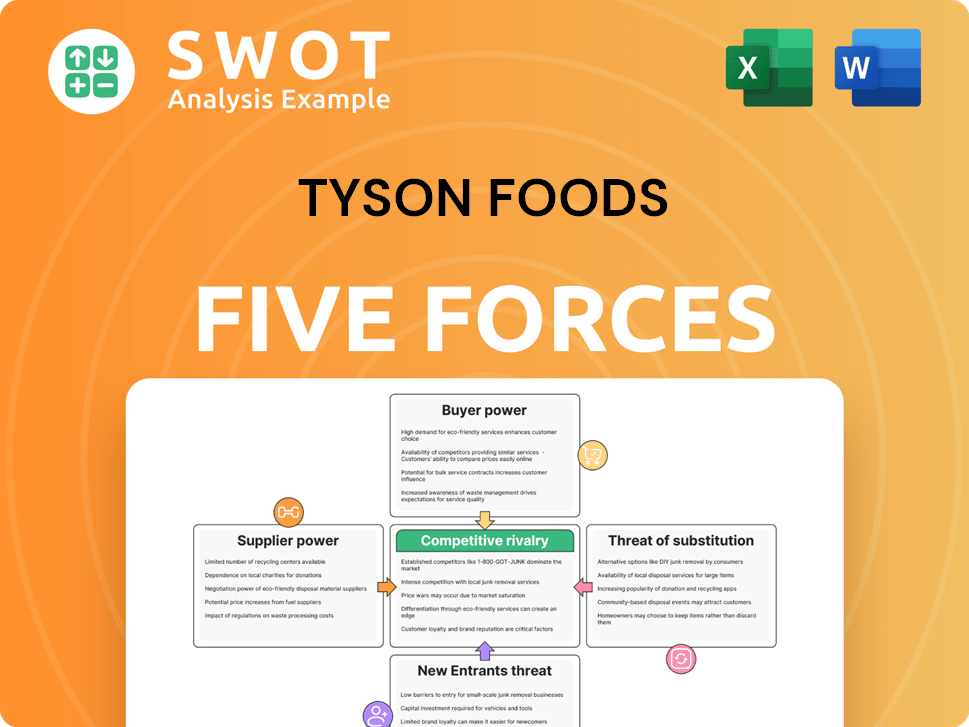
Related Blogs
- What are Mission Vision & Core Values of Tyson Foods Company?
- What is Competitive Landscape of Tyson Foods Company?
- How Does Tyson Foods Company Work?
- What is Sales and Marketing Strategy of Tyson Foods Company?
- What is Brief History of Tyson Foods Company?
- Who Owns Tyson Foods Company?
- What is Customer Demographics and Target Market of Tyson Foods Company?
Disclaimer
All information, articles, and product details provided on this website are for general informational and educational purposes only. We do not claim any ownership over, nor do we intend to infringe upon, any trademarks, copyrights, logos, brand names, or other intellectual property mentioned or depicted on this site. Such intellectual property remains the property of its respective owners, and any references here are made solely for identification or informational purposes, without implying any affiliation, endorsement, or partnership.
We make no representations or warranties, express or implied, regarding the accuracy, completeness, or suitability of any content or products presented. Nothing on this website should be construed as legal, tax, investment, financial, medical, or other professional advice. In addition, no part of this site—including articles or product references—constitutes a solicitation, recommendation, endorsement, advertisement, or offer to buy or sell any securities, franchises, or other financial instruments, particularly in jurisdictions where such activity would be unlawful.
All content is of a general nature and may not address the specific circumstances of any individual or entity. It is not a substitute for professional advice or services. Any actions you take based on the information provided here are strictly at your own risk. You accept full responsibility for any decisions or outcomes arising from your use of this website and agree to release us from any liability in connection with your use of, or reliance upon, the content or products found herein.